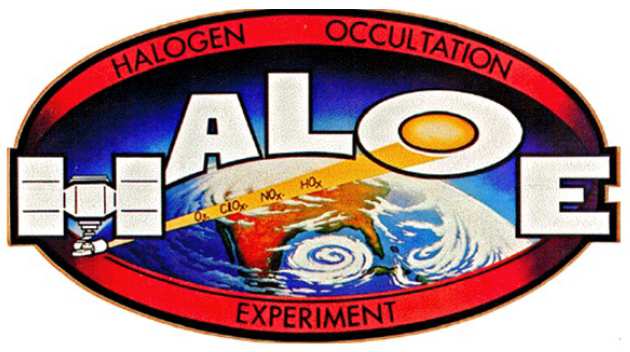Users Guide (Internal)
 The HALOE instrument flies on the Upper Atmosphere Research Satellite (UARS), and has been in operation since October 1991. It views solar infrared radiation by means of solar occultation, and measures water vapour, ozone, methane, hydrogen fluoride (HF), hydrogen chloride (HCl), nitrogen oxide (NO), nitrogen dioxide (NO2), temperature and aerosols. Latitudinal coverage is from 80oS to 80oN over the course of a year, and the altitude range of the measurements extends from 15 km to 60-130 km (depending on the constituent observed). Advantages of HALOE include high accuracy and self-calibration. In addition, HALOE is still in operation (at time of writing) and thus is very useful in the study of interannual variability of middle atmospheric constituents. Accordingly, the HALOE dataset forms a highly important basis of much middle atmosphere research.
The HALOE instrument flies on the Upper Atmosphere Research Satellite (UARS), and has been in operation since October 1991. It views solar infrared radiation by means of solar occultation, and measures water vapour, ozone, methane, hydrogen fluoride (HF), hydrogen chloride (HCl), nitrogen oxide (NO), nitrogen dioxide (NO2), temperature and aerosols. Latitudinal coverage is from 80oS to 80oN over the course of a year, and the altitude range of the measurements extends from 15 km to 60-130 km (depending on the constituent observed). Advantages of HALOE include high accuracy and self-calibration. In addition, HALOE is still in operation (at time of writing) and thus is very useful in the study of interannual variability of middle atmospheric constituents. Accordingly, the HALOE dataset forms a highly important basis of much middle atmosphere research.
Further information on HALOE is available from the HALOE homepage. The data is available from the BADC (UK) or the UARS central data handling facility, which also contains links to the homepages of other UARS instruments.
Current Research
John Harries heads the research effort at Imperial College. He is a member of the HALOE Science Team and played an important role in the development of the HALOE instrument. Recent HALOE papers include:
- Study of the Antarctic stratosphere in springtime, including evidence of drying in the Antarctic stratosphere (View the abstract) and absorbing layers (View the abstract).
- Validation of the HALOE water vapour retrievals (View the abstract).
- The distribution of mesospheric molecular hydrogen inferred from HALOE H2O and CH4 measurements (View the abstract).
Dr. R. Toumi is interested in recent observations of water vapour trends as seen by HALOE. It seems the stratopshere is getting wetter! (View the abstract)
Adam Hicks is examining HALOE nitric oxide and ozone measurements in the lower stratosphere, to identify important dynamical and chemical processes operating in this region of the atmosphere.